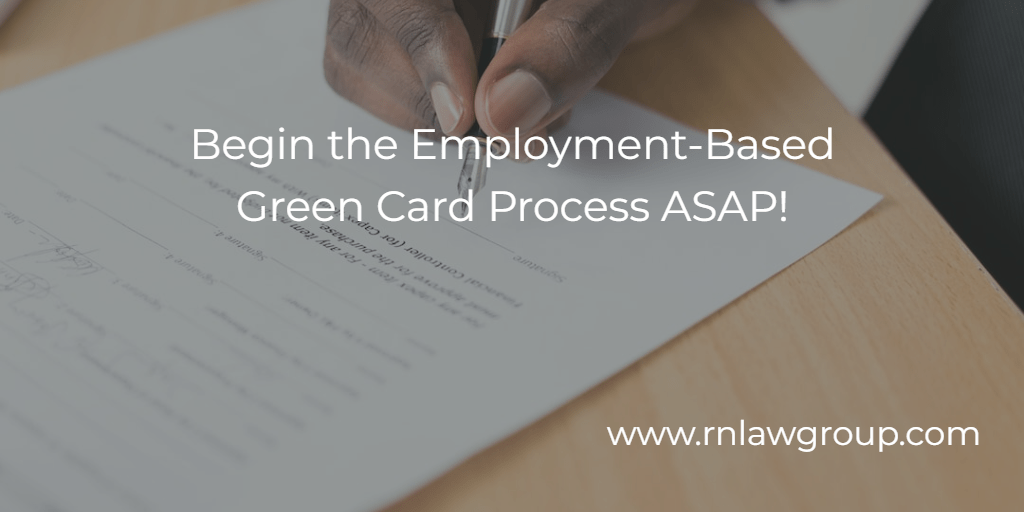
Begin the Employment-Based Green Card Process ASAP!
There are 3 steps to the employment-based green card process. The first is filing the PERM Labor Certification with the Department of Labor (DOL). By submitting the PERM Labor Certification, the employer is certifying that the U.S. labor market has been tested through good faith recruitment and through these efforts the employer was unable to find “able, willing, qualified, and available” U.S. workers for the offered permanent position. After the PERM Labor Certification is approved, the I-140 Immigrant Petition is submitted to U.S. Citizenship and Immigration Services (USCIS). This is a preliminary petition that establishes which employment-based category the beneficiary will be assigned to. Finally, the third step is the I-485 Adjustment of Status Application which is filed with USCIS and is the actual green card application. We can only move forward with this last step of the process if the beneficiary’s priority date is current, meaning a green card is immediately available to the beneficiary.
The date the PERM Labor Certification is filed establishes the beneficiary’s priority date. The priority date holds the beneficiary’s place in line for a green card. To put it into perspective, the Visa Bulletin shows a long line of people in the employment-based, second- or third-preference category (EB-2 or EB-3) whose country of birth is India. Unfortunately these people will wait many years before a green card is immediately available to them. For example, a beneficiary whose country of birth is India and has a priority date of October 08, 2011 in the EB-2 category can finally apply for a green card.
It is especially important for H-1B visa holders to begin the employment-based green card process as soon as possible. H-1B visa holders are limited to 6 years in H-1B status. However, the American Competitiveness in the Twenty-First Century Act of 2000 (AC21) allows H-1B visa holders to extend their H-1B visa beyond 6 years. For example, a beneficiary can get a 1 year extension if the PERM Labor Certification is filed at least 365 days prior to the day he/she reaches his/her 6th year limit on H-1B. In addition, a beneficiary can get 3 year extensions if he/she has an approved I-140 petition but his/her priority date is not yet current. The beneficiary can keep applying for these 3 year extensions until his/her priority date becomes current. Thus, with AC21, H-1B visa holders who are stuck in a long line can continue to stay in the U.S. beyond 6 years.
It is also important to begin the employment-based green card process as soon as possible as the DOL processing times have increased over the last couple of years. Based on current processing times, it could take more than a year to receive a PERM Labor Certification approval.
In order to file a PERM Labor Certification, the employer must first obtain a Prevailing Wage Determination (PWD) and test the U.S. labor market through various recruitment methods for able, willing, qualified, and available U.S. workers. The DOL reported that as of December 31, 2022, the National Prevailing Wage Center (NPWC) was issuing PWDs filed in January 2022 (OES and non-OES) or earlier. This would indicate almost a 13 month wait but our office has been seeing a 7 month wait.
The DOL also reported that as of December 31, 2022, it was processing PERM Labor Certifications filed in April 2022 or earlier. This would indicate almost a 10 month wait but our office has been seeing an 8 month wait. In the month of December 2022, it took the DOL an average of 255 calendar days to process PERM Labor Certifications (slightly over 8 months).
Further, as of December 31, 2022, the DOL was processing audits for PERM Labor Certifications filed in January 2022 or earlier. In the month of December 2022, it took the DOL an average of 356 calendar days to process audited cases. Therefore, if an audit was issued on a PERM Labor Certification, then slightly over 3 months were added to the total processing time of that PERM Labor Certification.
With PERM processing times increasing over the last couple of years, our office has seen more cases where H-1B visa holders cannot secure an approved PERM Labor Certification and I-140 petition prior to reaching their 6th year limit. As they approach their 6th year limit, these individuals must explore other options while the PERM Labor Certification and I-140 petition are pending, such as filing a change of status to another nonimmigrant visa or departing the U.S. and waiting abroad for their PERM Labor Certification and I-140 petition to be approved.
In sum, it is highly recommended to start the employment-based green card process as soon as possible to establish the beneficiary’s place in line for the green card if his/her country of birth is one that has a green card backlog. It is also important for those on a nonimmigrant visa, such as the H-1B visa, to get an approved PERM Labor Certification and I-140 petition prior to reaching their 6th year limit. Doing so allows the H-1B visa holder to extend their H-1B status beyond 6 years.
Because the U.S. immigration system can be tricky to navigate, it is always best to contact a qualified immigration attorney to help come up with the proper solution for each individual case.
Camille Joson is a Senior Associate Attorney in Reddy Neumann Brown PC’s PERM Labor Certification Department, where she assists clients in the beginning stages of the green card process.

